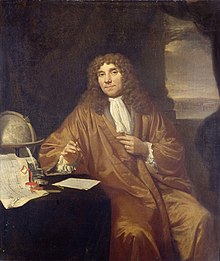
Back Antonie van Leeuwenhoek Afrikaans አንቶን ቫን ሉዊንሁክ Amharic Antoine van Leeuwenhoek AN أنطوني فان ليفينهوك Arabic انطونى فان ليفينهوك ARZ Anton van Leeuwenhoek AST Antoni van Levenhuk Azerbaijani آنتونی فان لیوونهوک AZB Антані ван Левенгук Byelorussian Антоні ван Леэўвэнгук BE-X-OLD
Antonie van Leeuwenhoek | |
|---|---|
 Portrait by Jan Verkolje, after 1680 | |
| Born | 24 October 1632 |
| Died | 26 August 1723 (aged 90) Delft, Dutch Republic |
| Known for |
|
| Scientific career | |
| Fields | |
| Signature | |
Antonie Philips van Leeuwenhoek[note 2] FRS (/ˈɑːntəni vɑːn ˈleɪvənhuːk, -hʊk/ AHN-tə-nee vahn LAY-vən-hook, -huuk; Dutch: [ˈɑntoːni vɑn ˈleːu.ə(n)ˌɦuk] ; 24 October 1632 – 26 August 1723) was a Dutch microbiologist and microscopist in the Golden Age of Dutch science and technology. A largely self-taught man in science, he is commonly known as "the Father of Microbiology", and one of the first microscopists and microbiologists.[5][6][7][8] Van Leeuwenhoek is best known for his pioneering work in microscopy and for his contributions toward the establishment of microbiology as a scientific discipline.
Raised in Delft, Dutch Republic, Van Leeuwenhoek worked as a draper in his youth and founded his own shop in 1654. He became well-recognized in municipal politics and developed an interest in lensmaking. In the 1670s, he started to explore microbial life with his microscope.
Using single-lensed microscopes of his own design and make, Van Leeuwenhoek was the first to observe and to experiment with microbes, which he originally referred to as dierkens, diertgens or diertjes.[note 3] He was the first to relatively determine their size. Most of the "animalcules" are now referred to as unicellular organisms, although he observed multicellular organisms in pond water. He was also the first to document microscopic observations of muscle fibers, bacteria, spermatozoa, red blood cells, crystals in gouty tophi, and among the first to see blood flow in capillaries. Although Van Leeuwenhoek did not write any books, he described his discoveries in chaotic letters to the Royal Society, which published many of his letters in their Philosophical Transactions.[10]
- ^ Lane, Nick (6 March 2015). "The Unseen World: Reflections on Leeuwenhoek (1677) 'Concerning Little Animal'." Philosophical Transactions of the Royal Society B: Biological Sciences . 2015 Apr; 370 (1666): doi:10.1098/rstb.2014.0344
- ^ Dobell, Clifford (1923). "A Protozoological Bicentenary: Antony van Leeuwenhoek (1632–1723) and Louis Joblot (1645–1723)". Parasitology. 15 (3): 308–319. doi:10.1017/s0031182000014797. S2CID 84998029.
- ^ Corliss, John O (1975). "Three Centuries of Protozoology: A Brief Tribute to its Founding Father, A. van Leeuwenhoek of Delft". The Journal of Protozoology. 22 (1): 3–7. doi:10.1111/j.1550-7408.1975.tb00934.x. PMID 1090737.
- ^ Dobell, pp. 300–305.
- ^ Chung, King-thom; Liu, Jong-kang: Pioneers in Microbiology: The Human Side of Science. (World Scientific Publishing, 2017, ISBN 978-9813202948). "We may fairly call Leeuwenhoek "The first microbiologist" because he was the first individual to actually culture, see, and describe a large array of microbial life. He actually measured the multiplication of the bugs. What is more amazing is that he published his discoveries."
- ^ Scott Chimileski, Roberto Kolter (25 September 2017). Life at the Edge of Sight. Harvard University Press. ISBN 9780674975910. Retrieved 26 January 2018.
- ^ "Antony van Leeuwenhoek Biography |". Biography Online. Retrieved 27 April 2023.
- ^ Robertson, Lesley; Backer, Jantien; Biemans, Claud; Doorn, Joop van; Krab, Klaas; Reijnders, Willem; Smit, Henk; Willemsen, Peter (2016). Antoni van Leeuwenhoek: Master of the Minuscule. Brill. ISBN 978-90-04-30430-7.
- ^ Anderson, Douglas. "Animalcules". Lens on Leeuwenhoek. Retrieved 9 October 2019.
- ^ "Antoni Van Leeuwenhoek | Encyclopedia.com". www.encyclopedia.com. Retrieved 29 July 2023.
Cite error: There are <ref group=note> tags on this page, but the references will not show without a {{reflist|group=note}} template (see the help page).
© MMXXIII Rich X Search. We shall prevail. All rights reserved. Rich X Search